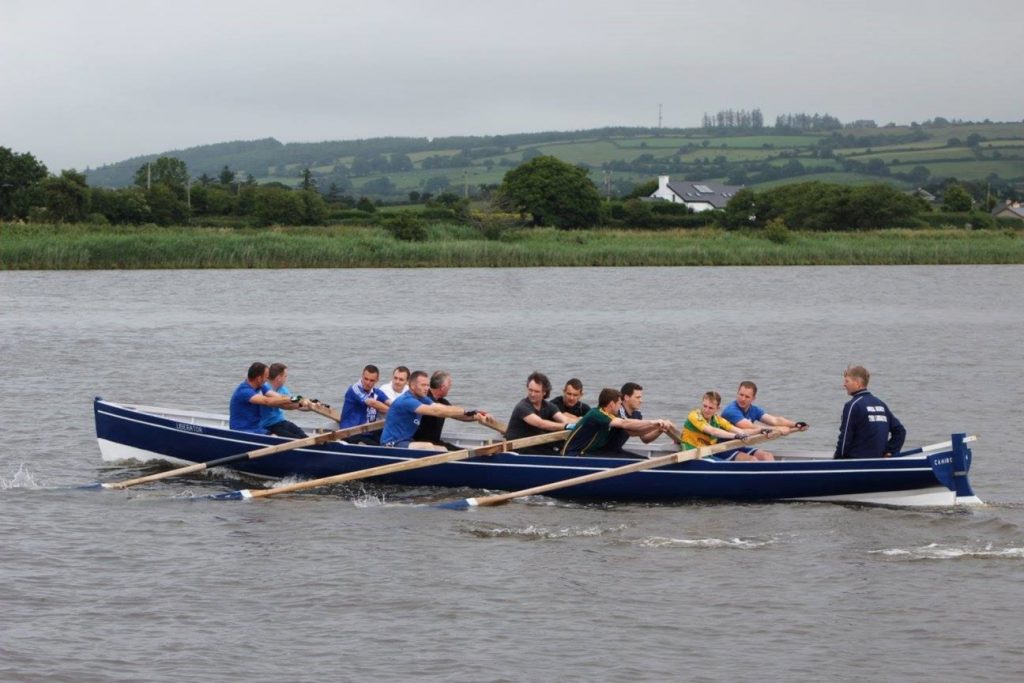
Traditional Seine Boat Building, Fishing and Racing
https://nationalinventoryich.chg.gov.ie/traditional-seine-boat-building-fishing-and-racing/
A seine boat is built in the carvel construction method. It is distinctive from a great many other similar sized boats which are generally of clinker construction owing to Norse and Scandinavian influence rather than the southern and western European style of boat building evident in the seine boat.
Seine boat fishing was in operation from the early 17th Century while seine boat racing at regattas throughout South Kerry has been a feature of the tradition since the 19th Century.
Background information
From the early seventeenth century, growing numbers of carvel-built rowing boats fished the large pilchard shoals that frequented the south west coast of Ireland. Operating in pairs, they fished with highly effective seine nets, trapping the pilchards in their thousands. There was a lucrative market for selling these pilchards in France, Spain, Portugal and Italy, but their appearance was sporadic and, by the early nineteenth century, the large shoals appear to have deserted the coast for good. The seine nets were then adapted to fish other species, especially mackerel and salmon. Mackerel fishing was an important local industry in the late 19th and early 20th centuries. In later years salmon was fished with seine nets but had effectively ceased by the 1970s.
From spring through autumn, hundreds of seine boats (each attended by a smaller boat – the follower) operated out of the many small coves and creeks in the Iveragh peninsula of south Kerry and neighbouring parts of west Cork. The seine boats ranged in size from 25ft to 34ft, with a maximum beam of 7 feet. Propelled by up to twelve oarsmen on double banked oars, they carried a helmsman or ‘Captain’ and sometimes a ‘Hewer’ or fish spotter in the bow. The smaller follower carried a maximum of six oarsmen and a helmsman.
Seine boat racing at regattas throughout south Kerry has been a feature of the tradition since the 19th century, and a vibrant tradition of seine-boat racing continues in the South-Mid Kerry region to the present day. Teams from several different coastal towns and villages compete in six-oar (twelve man) seine boat races. Success in seine fishing depends on the ability of the large crew of oarsmen to produce sustained bursts of speed, urged on by their Captain. Racing was a natural by-product of this rowing culture, with challenges between seine boats from neighbouring villages a frequent occurrence.
The racing model has evolved out of a trend among seine fishermen to request ever-lighter boats from boat builders, to gain an advantage at regattas. Understandably, boat builders were reluctant to comply as the more a boat was trimmed, the greater the chance of an upset. The sides of the racing boat are taken up sharper to achieve better lines for rowing, the capacity and stability of the boat being considerably reduced as a consequence. Today the rules governing traditional seine boat racing are regulated by the South & Mid Kerry Rowing Board. Seine boats are restricted to 34ft overall length and 6ft 3inch beam. The modern racing seine boat is essentially a trimmed and lighter version of the working boat.
The exceptional tradition of using double-banked oars (where two men pull on a single long, heavy oar) to propel the boat has been maintained since the early 17th century to present, calling to mind the method of rowing the Galley ships of the Middle Ages or the ancient Trireme of the Mediterranean.
Practice and practitioners
There are a number of traditional rowing clubs based in the South-Mid Kerry coastal region and all have various levels of interaction with Seine Boats by either hosting Regattas within their own communities during the Regatta season and/or providing a Seine Boat Crew to compete in the various regattas. The Regatta Season is held during the summer months when the weather is good enough to allow the races to be conducted safely and also allow spectators an opportunity to view and support their respective crews as the battle it out along the Wild Atlantic coastline.
Rural depopulation and an ageing demographic have meant that this tradition is under constant threat with fewer communities able to field a Seine Boat and crew. The fifteen communities and clubs that are traditionally involved may be considered the key practitioners of the sport and tradition. These clubs are;
- Killorglin RC
- Callinafercy RC
- Cromane RC
- Kells RC
- Over The Water RC
- Caherciveen RC
- Sive RC
- Valentia RC
- Portmagee RC
- Knockeen RC
- Ardcost RC
- Glen RC
- Ballinskelligs RC
- Waterville RC
- Caherdaniel RC
- Templenoe RC
- Sneem RC
The modern practice is particularly unique in that each oar of a Seine Boat is pulled by two oars men. Twelve oarsmen in each boat pulling six oars, 3 oars to the port and starboard sides of the boat. The crew is completed by a thirteenth person who is the coxswain (Captain) of the boat and crew. There are traditionally up to twelve locations suitable to host regattas during the summer racing season.
In terms of boat-builders, there are only a handful of people in the region with practical experience and knowledge of building and repairing a traditional wooden Seine Boat. Many of the boats currently used by crews have lasted decades and the original builders have since passed away. There is therefore limited time to capture this skill and knowledge before it would be required to be reverse engineered in order to understand the boat building techniques involved.
Development, transmission and safeguarding
The main practice and tradition of this activity is passed down through the various members of rowing clubs still able to put a seine boat and crew in the water to race during the regatta season. Participation has dwindled over recent years, a trend to be counteracted if the sporting tradition is to stay alive.
The craftsmanship in building such vessels and the many techniques involved in building the seine boats have been passed down from generation to generation on mostly an informal apprenticeship basis.
Seine Boats possess a distinctive set of Irish language terms to describe both the construction, handling, and associated equipment and techniques. There is a rich store of oral tradition and historical records documenting the social history of the boats, the fishing and the racing recorded from coastal communities in the region. From an academic perspective, much research and logging, including digital recording of old records relating to seine boat fishing etc has been captured and archived. Much of this is preserved in the Irish language. A substantial body of work has been done in capturing this data.
Rowing clubs have traditionally designed and built their own individual and unique trailer systems for transporting their Seine Boats to Regattas around the South-Mid Kerry coastal region. The Seine Boats in particular are quite heavy and often take more than just the crew to lift the boat back onto its trailer, particularly after a tough race. The sense of community and sportsmanship when crews and competitors help each other with this task is a unique and unspoken tradition.
The ancestry of the boat and its unique and enduring history, and the rich tradition and record of the people who worked it, distinguishes the craft in heritage terms. It evolved from a highly effective fishing craft, collectively owned and operated by individual village communities throughout the peninsula, to its role as an exceptional racing boat. The Seine Boat, powered by its large crew, is exceptional among Irish and European vernacular open rowing boats for its remarkable speed. This aspect in particular contributes to dramatic and exciting regattas, bringing together the various coastal communities in a celebration of local identity and great physical endeavour.
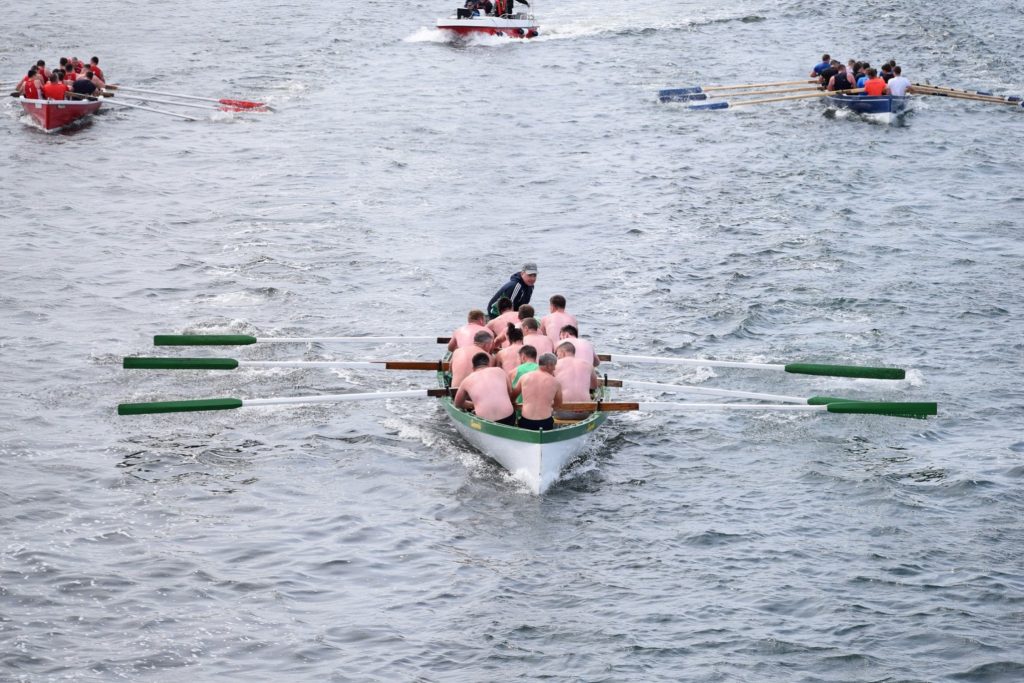
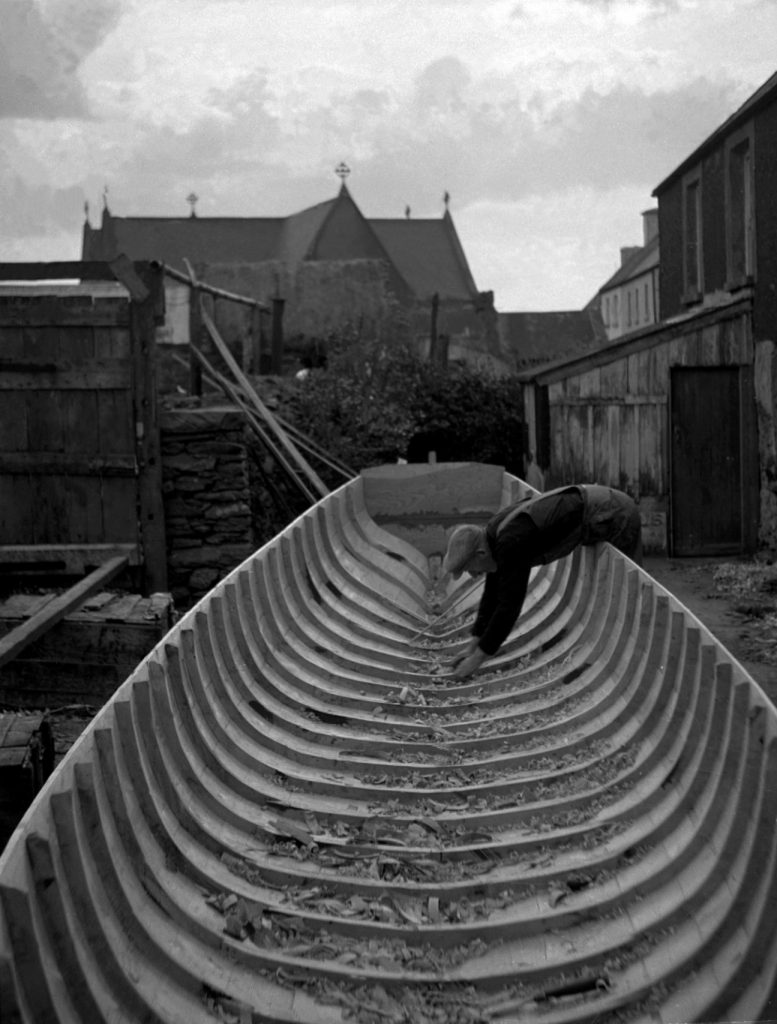
Broken oar, broken dreams? Not for our ’87 Seine crew.
The Kerryman
Liam Lynch – The Islandman
June 15 2019
A lot of tide has ebbed and flowed in the Portmagee Channel, situated between mainland Portmagee and the southern side of Valentia Island, since the Portmagee Regatta took place in its waters in 1987.
Thirty-two years on, and the seine boat race of that regatta was recalled with much joy, celebration, nostalgia, reminiscence and talk of times past at a very memorable occasion, complemented by a video of the occasion in the Ring Lyne Bar and Restaurant of Chapeltown on Friday, May 31.
Five boats participated, representing Valentia, Cahersiveen, Cnuicín, Rinn Rua-Ballinskelligs and Over-the-Water. Valentia won the race in dramatic circumstances and the reason for such a reunion was that it was one of the last all-Valentia crews to win or take part in a seine boat race.
The race commenced from the Valentia Bridge, with the boats not having travelled too far beyond the starting shot when a foul occurred between Valentia and Cnuicín to give us the most dramatic subsequent event of the race.
Top of Form
Bottom of Form
The foul resulted in a broken oar dowel of the third oar rowed by Patrick Morley and Nealie Lyne, rendering their oar idle. What followed was a sight to behold for patrons and tourists alike of the Ring Lyne as they watched the video in fascination.
Valentia, now with one oar rendered useless, naturally fell behind. However, Patrick Morley gallantly held the idle oar over his shoulders as his comrade on the oar, Nealie Lyne, frantically tried to remove the stub of the broken dowel and replace it anew as the boat stayed in the race.
Fascinating viewing.
Finally, though a fair amount of time was lost, he succeeded, and the crew once more commenced with six oars to a big cheer in the Ring Lyne.
But the determined islanders had a lot of water to make up and were up against it.
Gradually, ever so gradually, they pulled their way back into contention. And approaching the first buoy were in the thick of it with the leading boats.
The islanders were now going very well and actually rounded the first buoy in the lead, closely pursued by the Liberator, Cahersiveen.
The race for home westwards towards the Valentia Bridge was on, and it looked for a while as if the Liberator would overtake Valentia once more.
However, with the animated Valentia Cox, Paddy Jack O’Sullivan, sensing victory, standing in the stern and urging his men on, clad in a white shirt with two outstretched arms and clenched fists, the islanders pulled away.
The video commentator Christy Riordan of Cahersiveen uttered: “‘They are approaching the crowd on the Valentia Bridge, which they so often crossed, leading by six, seven lengths, maybe more.”
Valentia safely rounded the buoy westwards beyond the bridge and faced the short return distance back to the bridge to take the final shot of victory and be greeted by a dam-burst of delirious cheering and joy from the many islanders looking down from the Bridge.
It was a wonderful moment in time to savour for the crew, and Paddy Jack’s finest hour as a Valentia seine boat cox in front of their own people.
A herculean struggle for second place ensued with John ‘Cap’ and Cnuicín really pressing up on Mike Murt and the Liberator, but the Cahersiveen crew held on by half a length to finish second.
Time, of course, keeps on changing, and nothing stands still. The coxes of that far off year, Mike ‘Murt’ O’Connell (The Liberator), John ‘Cap’ Murphy (Cnuicín), Paddy Jack O’Sullivan (Valentia) and Jack Davy O’Connell (Rinn Rua-Ballinskelligs) have all passed to their eternal reward.
The only surviving cox is Johnny Keating of the Over-The-Water boat. Portmagee regatta committee members interviewed afterwards in the video – John Morley, Deo O’Connell, Johnny Moriarty and John Devane – have also passed on. God rest them all.
After the showing of the video in the Ring Lyne, Mícheál Lyne made a special presentation to Patrick Morley in view of his unique oar-lofting endeavours in the race.
It was great to see Patrick, who is well on the way to recovery from serious illness, attending on the night.
The festivities continued, and in celebration of that event of all those years ago, Mícheál Lyne rendered two recitations; Seanie Murphy gave two songs; Eileen Mort O’Sullivan sang, GG O’Sullivan also. Dermot Walsh lifted the roof with bagpipe tunes.
It all made for fascinating viewing for English and German tourists present, who were busy with their camera-phones and delighted in an affair of such native flavour.
The Valentia crew of 1987 was: Paddy Jack O’Sullivan (RIP), John O’Sullivan, Seamus Lynch (Stroke); Kevin Curran, Seamus O’Connor (Fifth Oar); Seanie Murphy, Mícheal Lyne (Fourth Oar); Patrick Morley, Nealie Lyne (Third Oar); Dermot Walsh, Patrick Lyne (Second oar); GG O’Sullivan, Gerard Burns (Bow Oar).
Footnote: GG O’Sullivan is the only current away-based crew member, being domiciled in Dublin since the ’70s.
All the rest currently reside in Valentia.
John O’Sullivan, head of the stroke oar, was the youngest crew member, with Mícheál Lyne being the most senior.
Many remarked on the amount of people present that day on the Valentia Bridge.
God be with the days.

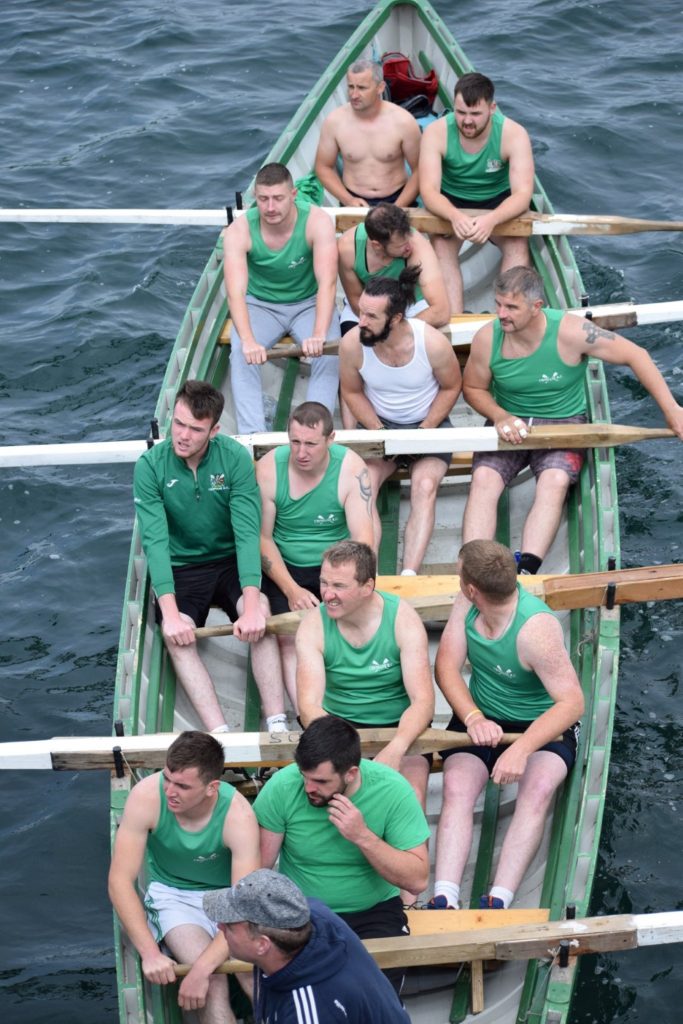
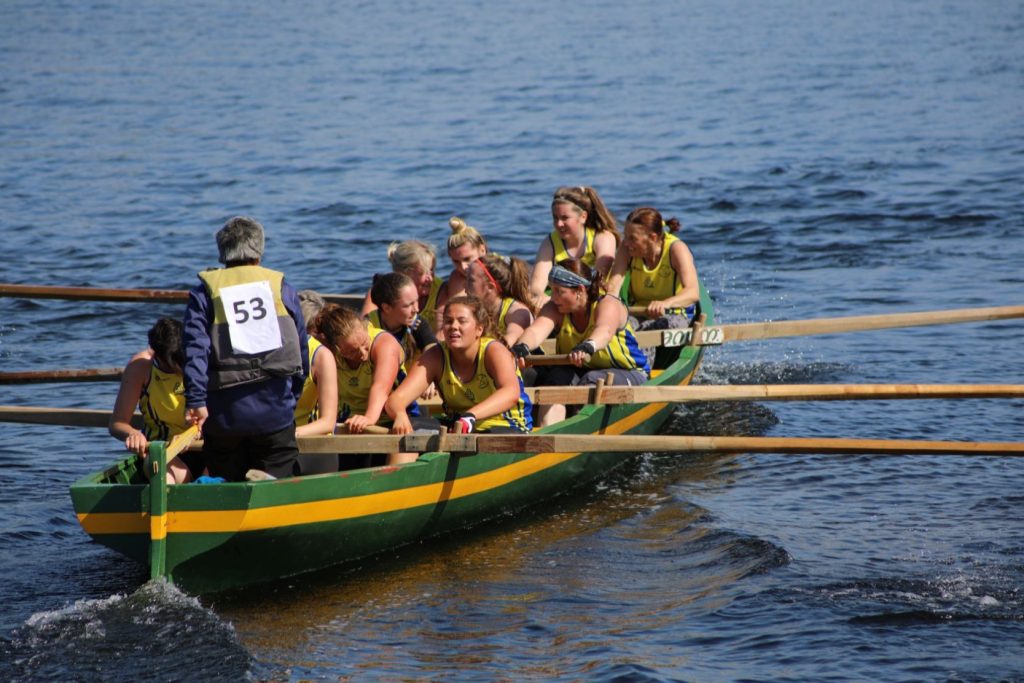
Rowing back the years
Irish Times
Saturday 22nd August 2009
https://www.irishtimes.com/life-and-style/rowing-back-the-years-1.723841
KERRY TRADITION: Regattas provide a vital link with the past for the coastal communities of Kerry as huge crowds gather to witness – and cheer on – a time-honoured tradition, writes MIRIAM MULCAHY
WHEN NIGHT FELL, they walked down to the harbour on the south Kerry coast and gathered at the water’s edge, and if the moon was out, all the better to see the shoals of mackerel they would chase that night.
Thirteen men rowed a Seine boat, and they were accompanied by a follower boat as well, to assist in the casting of the net, and to provide food throughout the long night’s fishing. Nets, weights and balances loaded, oars – long square poles that demanded proficient handling – and they were gone, out to sea, searching for the slivery glint of a mackerel shoal beneath the water.
All instructions were issued in Irish, and once they came upon a shoal, the Seine net was shot over one side of the boat, with the follower taking the rope, and the men rowing fiercely to make the net a circle and trap the shoal. A spotter stood in the prow, firing stones into the water to make sure any stragglers followed the horde. The two boats met, and the rope pulled, making a bag of the net, ready to be hauled back to shore.
ON A BALMY evening in Portmagee, when the air is still sultry from the lingering heat of the day, a huge crowd, locals and tourists, hangs over the bridge. The boats are lowered into the water, the rowers scramble in and take their places, two to an oar, eyes left on the water.
The cox commands them, and they head for the bridge. It takes time for the boats to line up, with much discussion of who’s who: the blue and white of Caherciveen is obvious, and Valentia’s red and yellow, Sneem in red and white.
The starter’s pistol cracks over the still water, and the boats take off, making for the buoy two miles away. Conversation turns to stories of the fine day as the boats recede into the blue distance. Interest sparks up again as they hove into view in a quarter of an hour, and all eyes strain to see who’s leading the field. “’Tis Valentia!” a shout goes up and is answered by hundreds of others, urging their local teams on as they approach the bridge.
Valentia and Sneem skim under the parapets, and the crowd dashes to the other side to see them pass the finishing buoy. The winners are applauded and the crowds disperse; the eight boats row back to the side of the bridge where they will be hauled in. It takes more than 20 men to lift one boat from the water.
Seine boats are carvel-built, wooden boats, more than 30 feet long and six feet wide. The oars are square, meaning they can’t be feathered in the water – making the boats harder to row. Thirteen men will get in and row five miles, two men to each long, square oar, one cox, five miles of back-breaking toil through uncertain seas. They row against neighbouring parishes in a fierce, proud spirit of competition.
Ballinskelligs, Sneem, Caherciveen, Cromane, Portmagee, Valentia, Knockeen – regattas are a huge part of these coastal communities, and the Seine boats are central to their history. Mackerel fishing as an industry has long since died out, but the tradition of using the boats for regattas at weekends was revived in the 1960s when Johnny Mahony of Ardcost, from a renowned rowing family, built 14 Seines.
Regattas were always popular during the summers, with Johnny Reidy, now in his eighties, remembering when “regattas and rowing were part and parcel of the sport in south Kerry for more years than most can remember. The last of the round-oar boat races was here in Portmagee in 1956. ’Twas rowed between the Mahonys of Ardcost, and a Ballinskelligs crew.”
In 1969, the Creation was built in Sneem, so called because “everyone had a hand in building her,” according to James Gleeson. Not to be outdone, Caherciveen rallied by building the Liberator in the early 1970s, named after the town’s most famous son, Daniel O’Connell.
The regattas run from May to September, on weekends, with the Seine boats always last to race. “It’s something to see, 90 or 100 men out rowing on a summer’s evening, you wouldn’t see it anywhere else in the world,” says Denis Daly of Caherciveen. The trophy is called after the man who brought the sport back to life, Johnny Mahony. Crews train twice a week, the races are five miles long, and take about 25 minutes. Leo Houlihan says the weather is immaterial. “Unless it’s blowing a gale, we go out.”
Daly wants to take a boat out one night with a follower and re-create the mackerel fishing. It’s easy to imagine him standing in the prow, searching for the silvery shoal, stones in hand, ready to fire them into the water. Now that would be a sight to see.
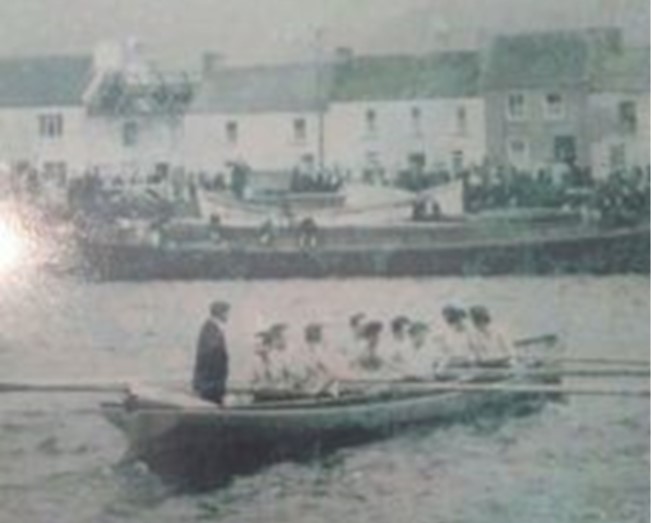
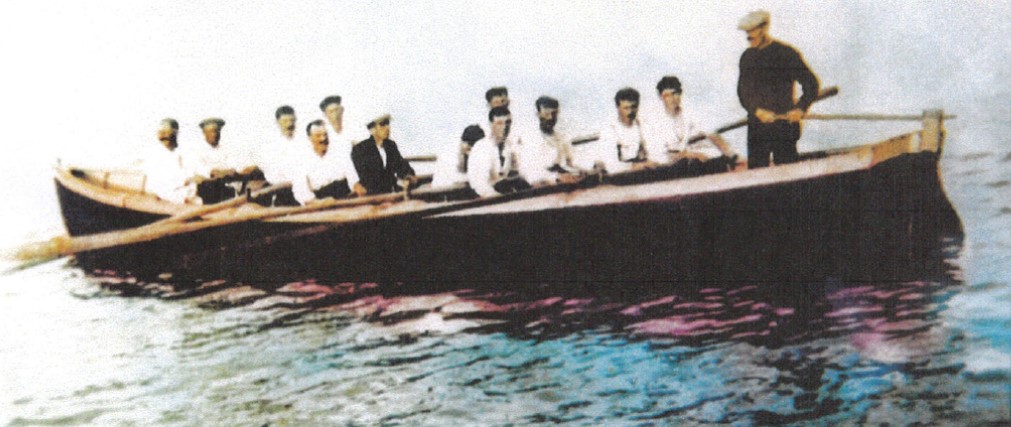
The South & Mid Kerry Rowing Board is the Class Association for the Seine Boat.